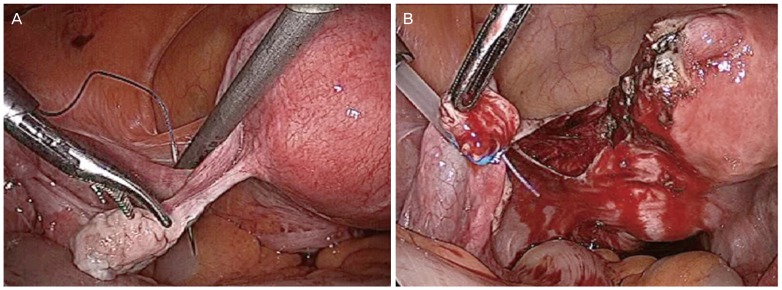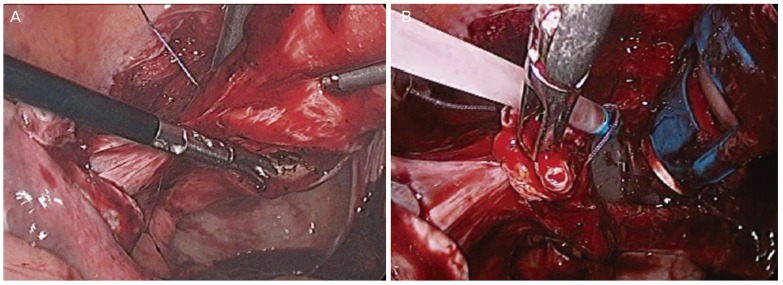Obstet Gynecol Sci.
2016 Jan;59(1):39-44. 10.5468/ogs.2016.59.1.39.
Total laparoscopic hysterectomy via suture and ligation technique
- Affiliations
-
- 1Department of Obstetrics and Gynecology, Gangdong Sacred Heart Hospital, Hallym University College of Medicine, Seoul, Korea. obgyn25@hallym.or.kr
- KMID: 2152642
- DOI: http://doi.org/10.5468/ogs.2016.59.1.39
Abstract
OBJECTIVE
The term 'total laparoscopic hysterectomy (TLH) with classical suture method' refers to a surgical procedure performed using only sutures and ligations with intracorporeal or extracorporeal ties, without using any laser or electronic cauterization devices during laparoscopic surgery as in total abdominal hysterectomy. However, the method is not as widely used as electric coagulation equipment for TLH because further advances in technology and surgical technique are required and operative time can take longer. In the current study, we evaluated the benefits of the classical suture method for TLH.
METHODS
This study retrospectively reviewed patients who received TLH using the classical suture method from August 2005 to April 2014. The patients' baseline characteristics were analyzed, including age, parity, cause of operation, medical and surgical history. Surgical outcomes analyzed included the weight of the uterus, operative time, complications, changes in hemoglobin level, blood transfusion requirements, and postoperative hospital stay.
RESULTS
Of 746 patients who underwent TLH with the classical suture method, mean operation time was 96.9 minutes. Mean average decline in hemoglobin was 1.6 g/dL and transfusion rate was 6.2%. Urinary tract injuries were reported in 8 patients. Urinary tract injuries comprised 6 cases of bladder injury and 3 cases of ureter injury. There were no cases of vaginal stump infection, hematoma, bowel injury or abdominal wound complication. All cases involving complications occurred before 2010.
CONCLUSION
The classical suture method for TLH presents tolerable levels of complications and blood loss. Advanced surgical skill is expected to decrease operation time and complications.
Keyword
MeSH Terms
Figure
Reference
-
1. Reich H, DeCaprio J, McGlynn F. Laparoscopic hysterectomy. J Gynecol Surg. 1989; 5:213–216.
Article2. Demco L, Garry R, Johns DA, Kovac SR, Lyons TL, Reich H. Hysterectomy. Panel discussion at the 22nd annual meeting of the American Association of Gynecologic Laparoscopists (AAGL), San Francisco, November 12, 1993. J Am Assoc Gynecol Laparosc. 1994; 1:287–295. PMID: 9050503.3. Elkington NM, Chou D. A review of total laparoscopic hysterectomy: role, techniques and complications. Curr Opin Obstet Gynecol. 2006; 18:380–384. PMID: 16794416.
Article4. Elkington N, Cario G, Rosen D, Carlton M, Chou D. Total laparoscopic hysterectomy: a tried and tested technique. J Minim Invasive Gynecol. 2005; 12:267–274. PMID: 15922986.
Article5. Chapron C, Fauconnier A, Goffinet F, Breart G, Dubuisson JB. Laparoscopic surgery is not inherently dangerous for patients presenting with benign gynaecologic pathology: results of a meta-analysis. Hum Reprod. 2002; 17:1334–1342. PMID: 11980761.
Article6. Seehofer D, Mogl M, Boas-Knoop S, Unger J, Schirmeier A, Chopra S, et al. Safety and efficacy of new integrated bipolar and ultrasonic scissors compared to conventional laparoscopic 5-mm sealing and cutting instruments. Surg Endosc. 2012; 26:2541–2549. PMID: 22447285.
Article7. Adelman MR, Bardsley TR, Sharp HT. Urinary tract injuries in laparoscopic hysterectomy: a systematic review. J Minim Invasive Gynecol. 2014; 21:558–566. PMID: 24462595.
Article8. Carbonell AM, Joels CS, Kercher KW, Matthews BD, Sing RF, Heniford BT. A comparison of laparoscopic bipolar vessel sealing devices in the hemostasis of small-, medium-, and large-sized arteries. J Laparoendosc Adv Surg Tech A. 2003; 13:377–380. PMID: 14733701.
Article9. Nogueira-Silva C, Santos-Ribeiro S, Barata S, Alho C, Osorio F, Calhaz-Jorge C. Total laparoscopic hysterectomy: retrospective analysis of 262 cases. Acta Med Port. 2014; 27:73–81. PMID: 24581196.10. Drahonovsky J, Haakova L, Otcenasek M, Krofta L, Kucera E, Feyereisl J. A prospective randomized comparison of vaginal hysterectomy, laparoscopically assisted vaginal hysterectomy, and total laparoscopic hysterectomy in women with benign uterine disease. Eur J Obstet Gynecol Reprod Biol. 2010; 148:172–176. PMID: 19926201.
Article11. Wallwiener M, Taran FA, Rothmund R, Kasperkowiak A, Auwarter G, Ganz A, et al. Laparoscopic supracervical hysterectomy (LSH) versus total laparoscopic hysterectomy (TLH): an implementation study in 1,952 patients with an analysis of risk factors for conversion to laparotomy and complications, and of procedure-specific re-operations. Arch Gynecol Obstet. 2013; 288:1329–1339. PMID: 23775263.
Article12. Vaisbuch E, Goldchmit C, Ofer D, Agmon A, Hagay Z. Laparoscopic hysterectomy versus total abdominal hysterectomy: a comparative study. Eur J Obstet Gynecol Reprod Biol. 2006; 126:234–238. PMID: 16616408.
Article13. Kale A, Aksu S, Terzi H, Demirayak G, Turkay U, Sendag F. Uterine artery ligation at the beginning of total laparoscopic hysterectomy reduces total blood loss and operation duration. J Obstet Gynaecol. 2015; 35:612–615. PMID: 25517762.
Article14. Song JY, Hwang SJ, Kim MJ, Jo HH, Kim SY, Choi KE, et al. Comparison of selective uterine artery double ligation at the isthmic level of uterus and bipolar uterine artery coagulation in total laparoscopic hysterectomy. Minim Invasive Ther Allied Technol. 2010; 19:224–230. PMID: 20642388.
Article
- Full Text Links
- Actions
-
Cited
- CITED
-
- Close
- Share
- Similar articles
-
- Study on Repairing Method of Vaginal Cuff in Total Laparoscopic Hysterectomy
- A new knotless parametrial tissue ligation technique for safe total laparoscopic hysterectomy
- Submucosal Hemorrhoidal Artery Ligation Technique and Shortening Suture Technique for a Hemorrhoidectomy
- Total laparoscopic hysterectomy by intracorporeal suture and ligature in the three-port method
- Comparison of Total Laparoscopic Hysterectomy with Laparoscopic-Assisted Vaginal Hysterectomy and Total Abdominal Hysterectomy



